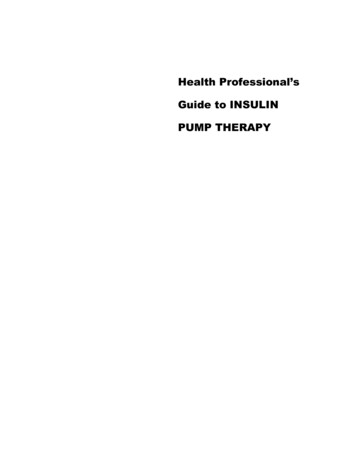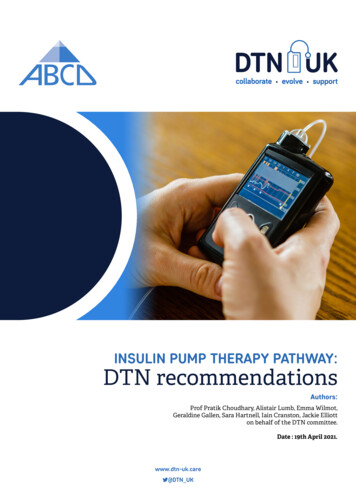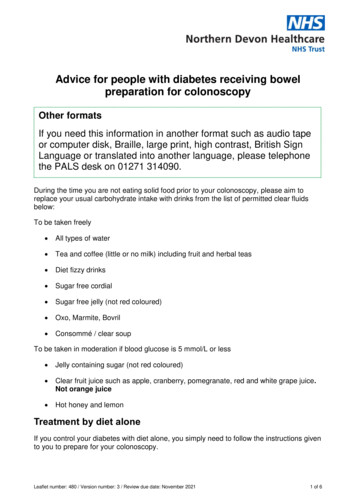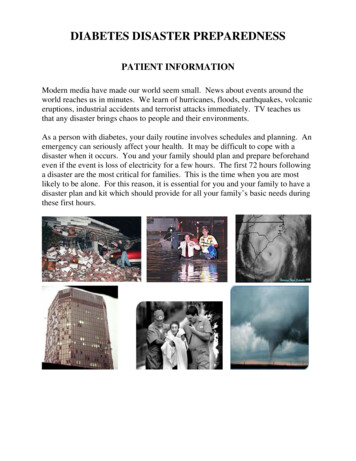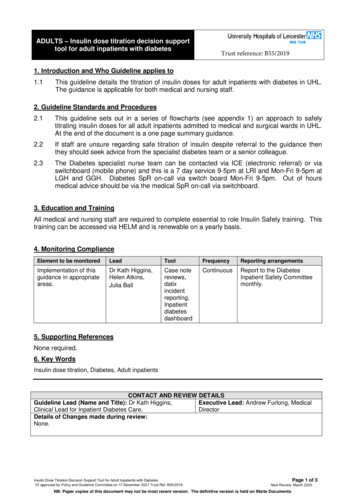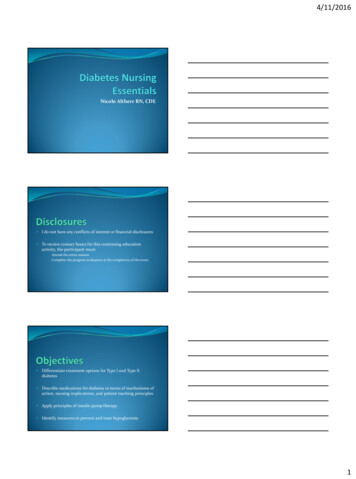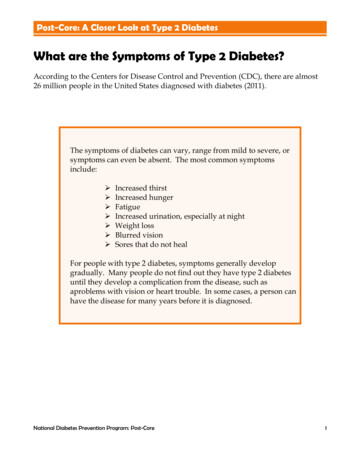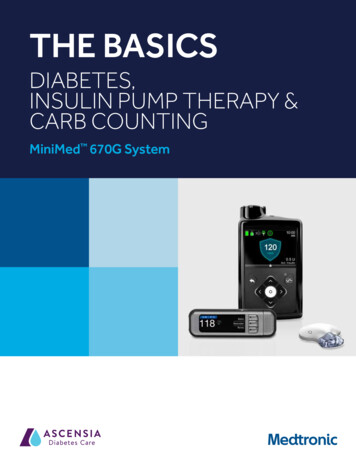
Transcription
THE BASICSDIABETES,INSULIN PUMP THERAPY &CARB COUNTINGMiniMed 670G System
TABLE OF CONTENTSTHE BASICSDIABETES, INSULIN PUMP THERAPY AND CARBOHYDRATE COUNTINGMINIMED 670G SYSTEMIntroduction.2Section 1: Diabetes and How the Body Works.3Section 2: Basics of Insulin Pump Therapy. 12Section 3: Carbohydrate Counting. 191
DIABETESIntroductionWhen you have diabetes, and need to take insulin every day, an insulin pump is a great tool to helpmanage your insulin and blood sugar (glucose) levels.This booklet will teach you the basics of:1. Diabetes and How the Body Works2. Insulin Pump Therapy3. Carbohydrate CountingLearning these concepts will help you better manage your glucose levels and be successful with insulinpump therapy.2
DIABETESSection 1: Diabetes and How the Body WorksWhat is Diabetes?Diabetes is a condition in the body where blood sugar levels are higher than normal. This can happenwhen the body either doesn’t make any insulin (type 1 diabetes), or the insulin that the body makesdoesn’t work well (type 2 diabetes). To better understand what diabetes is and how to treat it, it helps tolearn about how the body works.Glucose – The Body’s FuelThe body is made up of millions of cells, and every cell needs energy. Your body uses glucose, or sugar,for energy. You need some glucose in your body at all times to live, even while you all IntestineEvery cell in the body uses glucose for energyGlucose is the fuel your body uses for energy. Just like most cars need gas to run, the bodyneeds glucose to work.3
DIABETESHow the Body Gets Glucose for EnergyWhen you eat, food travels into your stomach and digestive system. There, food is broken down intonutrients, one of which is glucose. Then glucose gets absorbed into the bloodstream.Once in the bloodstream, glucose moves into the fluid that surrounds all your tissues and cells. Thisfluid is called the interstitial fluid.FoodDigestive SystemGlucose moving from bloodstream intothe Interstitial FluidAfter glucose enters the interstitial fluid, it moves into your cells with the help of a hormone calledinsulin. Insulin is the ‘key’ that unlocks the cell and allows glucose to enter. This gives your body the fuelit needs.Insulin Acts as a KeyGlucose moves into your cells with thehelp of insulinInsulin is the key that moves glucose inside your cells, so your body has energy to live.4
DIABETESExtra glucose that is not needed for energy right away is stored in the liver.Just like a car stores extra gas in its tank, yourbody stores extra fuel in your liver.Glucosestored inthe liverThe liver releases glucose back into the blood stream when a person needs energy and has not eatenfor a while. This happens during sleep and exercise.InsulinInsulin is a hormone made by the pancreas. Insulin lowers blood glucose levels by allowing glucose tomove out of the blood and into your body’s cells.Insulin lowersglucose levelsPancreasThe pancreas releases insulin 24 hours a day. The insulin is released in two ways: A small amount (basallevel) of insulin is released in between meals and while you sleep. A larger amount (a bolus) of insulin isreleased after eating.When you have diabetes, you may not make any insulin or not make enough insulin. So, you rely oninjectable insulin to lower your glucose levels.5
DIABETESGlucagonThe pancreas makes another hormone called glucagon. You can think of glucagon as the opposite ofinsulin, because glucagon raises glucose levels.Glucagonraises glucoselevelsPancreasWhen a healthy pancreas senses that glucose levels are dropping too low, it releases glucagon.Glucagon tells the liver to release some of the glucose it stored back into the blood stream. As theglucose enters the bloodstream, blood glucose (BG) levels start to rise.The pancreas makes two hormones that help to keep glucose levels in balance – insulin andglucagon.6
DIABETESCheck Your Knowledge! (Choose the best answer)1.2.3.The body’s main source of fuel or energy is:A.proteinB.fatC.glucoseis the ‘key’ that unlocks the cell and allows glucose to enter. This gives your body thefuel it needs.A.carbsB.insulinC.waterGlucose your body does not use right away is stored in theA.liverB.pancreasC.heartAnswers: 1. C 2. B 3. A7
DIABETESGlucose Levels in the BloodA person who does not have diabetes usually has glucose levels from 70 mg/dL to 120 mg/dL. Whenyou have diabetes, it is very difficult to keep glucose levels within such a tight range. A more reasonablerange for people with diabetes is from 70 mg/dL to 180 mg/dL. It is important to keep your glucoselevels within your ideal range and try to avoid highs and lows. Your healthcare professional will help youdecide the best glucose range for you.300 mg/dL240 mg/dL200 mg/dL180 mg/dL160 mg/dLReasonable range forpeople with diabetes140 mg/dL120 mg/dL100 mg/dLReasonable range forpeople without diabetes70 mg/dL50 mg/dLWhen you use your insulin pump and glucose sensor, your pump can help you track howmuch of the time your glucose levels are within the target range of 70 mg/dL to 180 mg/dL.This is called Time in Range.TIME IN RANGENow that Laura is on the pump and sensor, she tracks her Time in Range. Last month she increasedher time spent between 70 mg/dL and 180 mg/dL from 60% to 70%. This means she spent 2.4more hours a day in range.ADA RecommendationsBefore Meals80-130 mg/dL After Meals 180 mg/dLAACE RecommendationsBefore Meals 110 mg/dL After Meals 140 mg/dLADA: American Diabetes AssociationAACE: American Association of Clinical Endocrinologists8
DIABETESManaging High and Low Glucose Levels with DiabetesWhen you have diabetes, it’s important to try to avoid high and low glucose levels. Highs and lows don’tfeel very good in the moment, and they can damage your body in the long run.High Glucose:When you eat a meal, glucose levels start to rise. If there is not enough insulin in the body, glucose can’tmove into the cells. In this case, glucose will stay in the blood and interstitial fluid. More insulin is neededto lower blood glucose levels.228Too much glucoseNot enough insulinHigh blood glucoseMore insulin neededLow Glucose:When there is more insulin in the body than is needed, and there is not enough glucose, glucose levelswill drop. It’s important to drink or eat sugar to make blood glucose levels go back up to normal.68Too much insulinNot enough glucoseLow blood glucoseMust drink or eat sugarIf glucose is so low that you cannot eat or drink sugar, someone can give you an injection ofglucagon. Remember glucagon makes the liver release glucose into the blood, and glucoselevels will rise.9
DIABETESMaintaining Glucose Levels in Range with DiabetesThe goal in managing diabetes is to take the right amount of insulin to balance the amount of glucosein your body. This can be difficult to do sometimes, but the insulin pump can help make it easier.Keeping your blood glucose in target range will help you feel your best.InsulinGlucoseInsulin and glucose in balance10Glucose levels in normal range
DIABETESCheck Your Knowledge! (Choose the best answer)1.2.3.Insulin helps to blood glucose levels.A.raiseB.lowerGlucagon helps to blood glucose levels by telling the liver to release stored glucoseinto the blood.A.raiseB.lowerWhen you have diabetes, you must always eat or drink something with sugar if your glucose gets low.A.TrueB.FalseAnswers: 1. B 2. A 3. A11
DIABETESSection 2: Basics of Insulin Pump TherapyInsulin Delivery Using a PumpA healthy pancreas releases insulin throughout the day and night -- a small amount between meals andduring the night, and larger amounts when you eat food. An insulin pump mimics a healthy pancreas bycoming close to delivering insulin the way a healthy pancreas does.Insulin pumps are small computers that try to work like a pancreas.They hold several days’ worth of insulin and only use rapid- actinginsulin, like Humalog or NovoLog.No long-acting insulin is needed when you use an insulin pump.BasalThe pump automatically releases rapid-acting insulin every few minutes, 24 hours a day. This is thebasal rate, which you can think of as ‘background’ insulin delivery. The pump’s basal insulin delivery ismeant to match the liver’s steady release of glucose between meals and while you sleep.Basal insulinMidnight4 AM8 AMNoon4 PM8 PMTIMEBasal – matches the liver’s steady release of glucose12Midnight
DIABETESBolusA bolus is a larger dose of insulin given by you when you eat food, or any time you have a high bloodglucose (BG) value. This extra insulin is meant to match the rise in blood glucose levels. This deliveryallows the glucose to enter your cells.DinnerBreakfastLunchBolus insulinMidnight4 AMSnack8 AMNoon4 PM8 PMMidnightTIMEBolus – matches the rise in glucose levels, for example, after you eatInsulin Pump Therapy and Glucose MonitoringWhen you use an insulin pump, it is important to check your blood sugar periodically.Some people also use a continuous glucose monitor (CGM). This is a sensorthat lets a person continuously know their interstitial glucose levels with a newvalue every 5 minutes. We call this the sensor glucose (SG) value.13
DIABETESThe MiniMed 670G SystemThe MiniMed 670G system has two modes -- Manual Mode and SmartGuard Auto Mode. In ManualMode, it operates like a traditional pump. In Auto Mode, it can automatically adjust insulin.Manual ModeYour pump has basal and bolus settings that your healthcare professional willhelp you program. When you use your pump in this way, it is in Manual Mode.Basal RateThe pump automatically releases small amounts of insulin every few minutes, 24 hours a day. Youcan set different basal rates during the day and night to better match your body’s needs.Single Basal RateMultiple Basal RatesBolus DeliveryYou can give extra insulin (a bolus) when you want to eat a meal or correct a high blood sugar. InManual Mode you can give yourself a bolus in two different ways:1. Use the pump’s Bolus Wizard feature to help calculate how much insulin to take2. Program the pump to deliver the units of insulin you would like to takeSmartGuard Auto ModeWhen your pump is not in Manual Mode, it is in Auto Mode. The pumpautomatically adjusts basal insulin delivery every 5 minutes based on yoursensor glucose levels.Basal insulin adjusting every 5 minutesWe call this technology Auto Mode, because it automatically adjusts insulin delivery.Since insulin is adjusted based on sensor glucose levels, a person must wear aglucose sensor. Some people call this a continuous glucose monitor, or CGM.145:00PM120mg/dL0.5 UAct. Insulin
DIABETESIn Auto ModeWhen you want to eat food:1. Enter the grams of carbs you are eating into the pump2. Tell the pump to deliver a bolusWhen you want to correct a high BG value1. Enter the BG value into the pump. Auto Mode will calculate how much insulin (it thinks) your bodyneeds at that time.2. Tell the pump to deliver a bolusThink of Auto Mode as your co-pilot when you are awake— assisting you with your basalrate adjustments while you decide how much insulin to take for meals.Think of Auto Mode as your auto-pilot when you are asleep— gradually adjusting yourinsulin delivery to help keep your glucose levels in range.LAURA IN SMARTGUARD AUTO MODESmartGuard Auto Mode takes care of most of my glucose fluctuations without me having to eventhink about it. And if my pump needs me to check my BG to stay in Auto Mode, then my pump willlet me know. Since using Auto Mode, I spend more time in range, have fewer lows, and worry less.**Some interaction required. Individual results may vary.15
DIABETESHow Pump Therapy Compares to InjectionsHere are a few ways that insulin pump therapy compares to injections:1. Insulin AbsorptionWhen taking multiple daily injections, a person needs both long-acting insulin and rapid- acting insulin.When using a pump, only rapid-acting insulin is needed.The disadvantage of using long-acting insulin is that a large volume of insulin is injected at one time.This can lead to insulin “pooling” under the skin, and less consistent absorption day-to-day.The advantage of using rapid-acting insulin is that smaller amounts of insulin are delivered, so the bodyhas more consistent absorption day-to-day, which helps you manage your glucose levels.SyringeInfusion SetSkinSkinFatFatInsulinBloodstreamLong-acting insulin can “pool” under the skinleading to inconsistent absorptionInsulinBloodstreamRapid-acting insulin is delivered in tinyamounts, so it absorbs more consistently2. Stopping Insulin DeliveryWith long-acting insulin, you cannot take back the insulin once you haveinjected it. It’s there working in your body whether you want it to or not. This cansometimes cause lows during and after exercise.STOP16With an insulin pump, you can change the amount of insulin you receive moreoften. In a pump system with Auto Mode, the pump will automatically deliverless insulin or stop your insulin delivery completely when it senses your glucoselevels dropping. Lowering or stopping your basal insulin delivery may help avoidlows, especially during and after exercise.
DIABETES3. Always Having Your Insulin With YouWith multiple daily injections, it’s easy to forget your insulin athome, and unfortunately if you do, you must skip a dose of insulin.This almost certainly leads to high glucose levels.With an insulin pump, you always have your insulin with you tobolus for food or to correct a high BG. Always having your insulinthere when you need it helps you avoid highs and better manageyour glucose levels.Staying Safe with Insulin Pump TherapyThere are many advantages of using an insulin pump, but you need to stay safe whileusing one. The pump uses only rapid-acting insulin which doesn’t stay in your bodyfor long. Your glucose levels can rise quickly if basal insulin is stopped or if your pumpbecomes disconnected without you knowing it. It is important to monitor glucose levelswhen using or being disconnected from a pump. So never ignore a high glucose reading.Why Insulin Pump Therapy?Insulin pump therapy may make managing your glucose levels easier, so you can spend time enjoyinglife and worrying less about diabetes.LIFE WITH A PUMPWhen Laura started using the MiniMed 670G system, her life changed. She eats when she wantsto, not when she has to. Her pump can adjust the amount of insulin she gets every 5 minutes tobetter match what her body actually needs. With an insulin pump, managing her diabetes is a wholelot easier.17
DIABETESCheck Your Knowledge! (Choose the best answer)1.2.3.What type of insulin is used for insulin pump therapy?A.Long-acting insulinB.Rapid-acting (U100) insulinC.Basal insulinA pump with SmartGuard Auto Mode can automatically adjust insulin levels every 5 minutes.A.TrueB.FalseI still need to bolus for carbs if I use a pump with SmartGuard Auto Mode.A.TrueB.FalseAnswers: 1. B 2. A 3. A18
CARB COUNTINGSection 3: Carbohydrate CountingFood is made up of protein, fat and carbohydrate (carb). When carbs are digested, they get brokendown into glucose, which makes blood glucose levels go up. Carb counting is adding up the grams ofcarbs you want to eat, so that you can give the right amount of insulin for the food you eat.Why Count Carbs?Match your insulin to the food you want to eatBetter manage glucose levels to avoid highs and lowsCounting carbs with an Insulin PumpTell your pump how many carbs you are eating, and the pump will estimate how much insulin to takeusing its calculatorWhen using a pump with Auto Mode, you must tell your pump how many grams of carbs you want to eatMore carbseatenMore glucosein bloodMore insulinneededLess carbseatenLess glucosein bloodLess insulinneededYour healthcare professional will help you figure out your insulin dose based on how manycarbs you are eating.19
CARB COUNTINGCarb Counting ToolsOne of the most important parts of carb counting is knowing how much of a certain food you areeating. You can use:Measuring Cups and SpoonsMeasuring cups, spoons and a food scale are helpful tools for practice. Measuring helps give you a goodvisual idea of how different serving sizes look like on a plate, bowl or glass which helps you to betterestimate when you are not at home.Your HandsYour hands can also help you estimate portion sizes, especially when you are away from homeCupped hand 1/2 cupFist 1 cupOther Resources that you may find helpful:MyFitnessPal -- Calorie Counter & Diet TrackersCalorieKing Food Search app, or www.calorieking.comCarb Counting with LennySM game and app for children, or www.lenny-diabetes.comAmerican Diabetes Association www.diabetes.org20
CARB COUNTINGMethods for Carbohydrate CountingThere are different ways to count carbohydrates. You may use one or a combination of the differentmethods.Estimating Carbohydrates – 15-gram servingsEstimating carbs is based on serving sizes that have about 15 grams of carbohydrate. This method canbe helpful when you are, for example, eating at a restaurant and no food labels or nutrition informationis available.Here are food groups and serving sizes that contain approximately 15 grams of carbs:Starches1 slice of bread6 crackers6” tortilla3/4 cup cereal1/3 cup rice or pasta1/4 bagel1/2 cup starchy vegetables, like corn, peas, beans, lentilsFruits and fruit juices1/2 cup juice1 tennis ball-sizedapple or orange1/2 bananaMilk and yogurt1 cup milk (skim, low-fat or whole)6-8 oz of light yogurtSweets, desserts and other carbohydrates2” square ofunfrosted cake1/2 cup ice creamor pudding1 tbsp honey,syrup or jelly2 small cookiesDon’t forget sweetened sports drinks and candyFor a more complete list of foods and 15 gram servings, see page 26.21
CARB COUNTINGNutrition LabelsReading Nutrition Facts labels is very helpful when counting carbs. Even though there are many itemson a Nutrition Facts label, there are only two things that you should focus on:1. Serving Size:First check the serving size shown on the label.You may be eating more than the amount listed as theserving size. For example, if the serving size is ½ cup andyou are eating 1 cup, then you are eating two servings.Nutrition FactsServing Size: 1/2 cup (56g) dryServings per container: 8Amount Per ServingCalories 210Fat Cal. 10% Daily Value2. Total Carbohydrates grams (g):Check the total grams of carbohydrate to get thecomplete picture of the effect on your glucose levels.For this food: 1/2 cup serving 42 grams of carbs 1 cup serving 84 grams of carbsTotal Fat 1gSaturated Fat 0gPolyunsaturated Fat 0.5gMonounsaturated Fat 0gTrans Fat 0.5gCholesterol 0mgSodium 0mg0%Total Carbohydrate 42g 14%Dietary Fiber 2g8%Sugars 3gOther carbohydrate 37gProtein 7gVitamin AVitamin CCalciumIron0%0%0%10%An example and not a real item.Sugar free does not mean carbohydrate free. Always check the label for TotalCarbohydrate.CARB COUNTING WITH AN INSULIN PUMPBecause Laura counts carbs, she has more freedom when making food choices. She knows thatwhen she adds up her carbs, her pump will estimate the amount of insulin she needs for the foodshe is eating. Carb counting and her insulin pump help keep her glucose levels in an ideal range.22
CARB COUNTINGCarb Meal SizeYour healthcare provider may ask you to guess how many grams of carbs you are eating based on yourmeal’s carb size.When you examine your meal sizes and their carb content, you may be able to come close to knowinghow many grams of carbs you are eating by guessing your “carb meal size.”For example, a healthcare professional may help one patient figure out that a typical small carb snackmight be about 15 grams of carbs. A small carb meal might be 30 grams of carbs, a medium carb mealmight be 60 grams of carbs, and a large carb meal might be about 90 grams of carbs. Another patient,for example, might have different carb meal sizes, where small is 30 grams of carbs, medium is 45grams of carbs and large is 60 grams of carbs.15 grams of carbs(1 small piece of fruit)30 grams of carbs(2/3 cup rice 1 cup lettuce)60 grams of carbs(3 small tortillas, ½ cupbeans, 1/3 cup rice)90 grams of carbs(2 cups of pasta)Whatever your method of estimating carbs is, work with your healthcare professionalto pick the one that works for you and makes managing your glucose levels easier.23
CARB COUNTINGProtein and FatCarbohydrates impact glucose levels the most, but protein and fat (especially in large quantities) canaffect glucose levels too. Foods that contain mostly protein and fat: eggs, meat, seafood, cheese, oils,and nuts.ProteinThere are increasing numbers of people eating more protein and limiting their carbohydrates in an effortto manage their glucose levels. For meals that are high in protein, and have little to no carbs, such asscrambled eggs, they may find they need insulin based on the amount of protein in their meal. For thisgroup of people, the Chief Medical Officer at Medtronic suggests counting grams of protein, dividinggrams of protein in half, then taking insulin per their carb ratio for half the protein grams. Additionally,this insulin may need to be spread out over time, which can be done using a Dual Wave bolus in ManualMode. In Auto Mode, a patient can give multiple boluses to spread out their insulin over time.Example:2 eggs for breakfast2 eggs 12 grams of proteinEnter 6g in bolus calculatorWhen bolusing forprotein and fat, checkglucose levels moreoften to see what worksbest. Be sure to discuss this withyour healthcare team.FatFoods that are high in fat like cheese or meat, or 100% fat like oils, may impact glucose levels in twoways. Some people become more resistant to insulin when consuming foods high in fat, and thereforethey require additional insulin. Fat also slows down digestion, which affects glucose levels. So, thecarbohydrates eaten along with the fat move into the blood stream more slowly. For a person eatingfood with a high amount of fat and carbohydrates, for example a quesadilla, pizza, or fast food, theymay need to spread out their insulin over time.Example:2 slices of pizzadetermine the total grams of carbs in the pizzaOne option in Auto Mode is to bolus for 50% or 75% of the carbs inadvance of eating, and bolus for the remainder in an hour.Another option in Auto Mode is to bolus for 100% of the carbs in advance of eating, and checkglucose levels after 1-2 hours and give a correction bolus if Auto Mode recommends one.24
CARB COUNTINGCheck Your Knowledge! (Choose the best answer)1.2.Which of these foods contain carbohydrates?CornPotatoRiceCrackersSugar-free cookiesHoneyBreadDiet sodaSkim milkCoffee (black)TunaCheeseGreen beansTurkeyCerealPopcornApple juicePinto beansOrangeLemonadeFrench friesMargarineYogurtBroccoliWrite True or False next to each statement:You should always try to avoid eating carbohydrates.Selecting healthy carbohydrates and being careful about portion sizes willprovide your body with valuable nutrients.The more carbs you eat, the more insulin you need.3.Which two things should you focus on when using a nutrition label to count carbs?A.FiberB.SodiumC.Serving SizeD.Total Carbohydrates25
CARB COUNTING4.Use the label to answer the following questions:One serving equals:A.1 packageB.2 barsC.6 barsNutrition FactsServing Size 2 bars (42g)Servings Per Container 6Amount Per ServingCalories 160Fat Cal. 50% Daily Value*2 bars grams of carb1 bar grams of carb3 bars grams of carbTotal Fat 6gSaturated Fat 0.5gTrans Fat 0gCholesterol 0mgSodium 400mgTotal Carbohydrate 36gDietary Fiber 2gSugars 11gProtein 3g9%3%0%6%9%8%An example and not a real item.Answers: 1. Corn, Potato, Rice, Crackers, Sugar-free cookies, Honey, Bread, Skim milk, Green beans,Cereal, Popcorn, Apple juice, Pinto beans, Orange, Lemonade, French fries, Yogurt, Broccoli2. False, True, True 3. C, D 4. 36, 18, 5426
CARB COUNTINGEstimating Carbohydrates – 15 gram servingsThis list shows the serving sizes of various foods that contain 15 grams of carbohydrate. You can lookfor the foods you commonly eat and become familiar with the serving size that equals 15 grams.StarchesEach serving listed contains about 15 grams ofcarbohydrateBagelBiscuit, 2 1/2” acrossBread (white, wheat, rye)Cornbread, 2” squareCroutonsEnglish muffinsHamburger/ hot dog bunPancake, 4” acrossPita, 6” acrossPopcornRoll, plain, smallSnack chips (potato, tortilla)Stuffing, preparedTortilla, 6” acrossWaffle, 4” across1/4 (1 oz)11 slice11 cup1/2 bun11/23 cups19-131/2 cup11Other StarchesEach serving listed contains about 15 grams ofcarbohydrateBrownie, 2” squareCake, unfrosted, 2” squareCake, frosted, 2” squareCookie, smallGelatin, regularHoneyJam or Jello, regularPudding, regularSalad dressing, fat freeSherbet, sorbetSyrup, light111/221/2 cup1 tbsp1 tbsp1/4 cup1/4 cup1/4 cup1Starchy VegetablesEach serving listed contains about 15 grams ofcarbohydrateBaked beansBeans (garbanzo, pinto, black, white)CornCorn on the cob, 6” earLentilsLima beansMixed vegetablesPeas (green, split, black-eyed)Potato, 3 ozPotato, mashedSquash, winterYam/sweet potato1/2 cup1/2 cup1/2 cup11/2 cup2/3 cup1 cup1/2 cup11/2 cup1 cup1/2 cupCombination FoodsEach serving listed contains about 15 grams ofcarbohydrateChili with beansSoup (cream, broth)Split pea soupThin crust pizza 1/8 of 12”Macaroni and cheeseLasagna, 4” x 4”1/2 cup1 cup1/2 cup1 slice1/2 cup1 cupFruit JuiceEach serving listed contains about 15 grams ofcarbohydrateApple, grapefruit, orange and pineappleCranberry, grape, and pruneCranberry juice cocktail, reduced calorie1/2 cup1/3 cup1 cup27
CARB COUNTINGCereal and GrainsEach serving listed contains about 15 grams ofcarbohydrateBran cerealsCereals, cookedCereals, unsweetened, ready-to-eatGranola, low fatGrits/oats, cookedPastaPuffed cerealRice1/3 cup1/3 cup3/4 cup1/4 cup1/2 cup1/3 cup1 1/2 cup1/3 cupFruitEach serving listed contains about 15 grams ofcarbohydrateApple, smallApricots, freshBanana, smallBlackberries/blueberriesCantaloupe/honeydew cubesCherriesFruit, cannedGrapefruit, largeGrapes, smallKiwiOrange, smallPeach, mediumPeach, largePineapple, freshPlums, smallRaisinsRaspberriesStrawberries, wholeWatermelon1 (4 oz)4 (5 1/2 oz)1 (4 oz)1/4 cup1 cup12 (3 oz)1/2 cup1/2 (11 oz)17 (3 oz)1 (3 1/2 oz)1 (6 1/2 oz)1 (4 oz)1/2 (4 oz)3/4 cup2 (5 oz)2 tbsp1 cup1 1/4 cups1 1/4 cupsAdapted from: Basic Carbohydrate Counting [brochure], AmericanDiabetes Association, Inc. and American Dietetic Association; 2003.Kulkarni K. Warshaw HS. Why count carbs? In: Landrum S, ed. CompleteGuide to Carb Counting. 2nd ed. Alexandria. VA. American DiabetesAssociation; 2004: 211-255.28MilkEach serving listed contains about 12 grams ofcarbohydrateMilk:Fat free, 1%, 2% or wholeButtermilkEvaporated MilkYogurt:Flavored, fat-free, lightPlain, fat-freePlain1 cup1 cup1/2 cup2/3 cup (6 oz)2/3 cup (6 oz)1 cupNon-starchy vegetablesOne cup raw or 1/2 cup cooked serving of vegetablescontains about 5 grams of carbohydrateArtichokeAsparagusBeans (green, rGreens (collard, mustard)MushroomOkraOnionsPea podsPeppersSalad greens (lettuce)SpinachSummer squashTomato/tomato juiceTomato/vegetable juiceZucchini
IMPORTANT SAFETY INFORMATIONWARNING: (For MiniMed 670G System Users Ages 7-13): The low sensor glucose alert functionality is distinct from theautomated insulin dosing function of the MiniMed 670G system. When used in Auto Mode, the MiniMed 670G systemhas been shown to be safe and effective for its intended use in this population. However, do not rely solely on the use ofa low sensor glucose (SG) value for “Alert on Low” or “Alert before Low” for alerts set at 50 mg/dL and 60 mg/dL. A lowsensor glucose alert may not reflect the user’s true blood glucose at these levels or may not alert. Do not ignore symptomsof low glucose. Always confirm your sensor glucose readings with your blood glucose meter and treat according to therecommendations of your healthcare professional. Solely relying on these sensor glucose alerts and readings for treatmentdecisions could result in missing severe hypoglycemia (low blood glucose) events.IMPORTANT SAFETY INFORMATIONMINIMED 670G SYSTEMThe Medtronic MiniMed 670G system is intended for continuous delivery of basal insulin (at user selectable rates) andadministration of insulin boluses (in user selectable amounts) for the management of type 1 diabetes mellitus in persons,seven years of age and older, requiring insulin as well as for the continuous monitoring and trending of glucose levels inthe fluid under the skin. The MiniMed 670G system includes SmartGuard technology, which can be programmed toautomatically adjust delivery of basal insulin based on Continuous Glucose Monitor sensor glucose values, and can suspenddelivery of insulin when the sensor glucose value falls below or is predicted to fall below predefined threshold values. Thesystem requires a prescription. The Guardian Sensor 3 glucose values are not intended to be used directly for makingtherapy adjustments, but rather to provide an indication of when a fingerstick may be required. A confirmatory finger sticktest via the CONTOUR NEXT LINK 2.4 blood glucose meter is required prior to making adjustments to diabetes therapy. Alltherapy adjustments should be based on measurements obtained using the CONTOUR NEXT LINK 2.4 blood glucosemeter and not on values provided by the Guardian Sensor 3. Always check the pump display to ensure the glucose resultshown agrees with the glucose results shown on the CONTOUR NEXT LINK 2.4 blood glucose meter. Do not calibrate yourCGM device or calculate a bolus using a blood glucose meter result t
When you have diabetes, you must always eat or drink something with sugar if your glucose gets low. A. True B. False Answers: 1. B 2. A 3. A DIABETES. 12 Section 2: Basics of Insulin Pump Therapy Insulin Delivery Using a Pump A healthy pancreas releases insulin throughout the day and night -- a small amount between meals and
